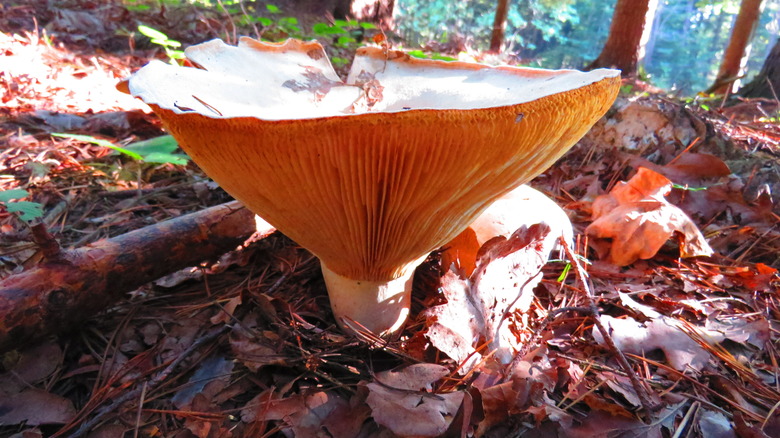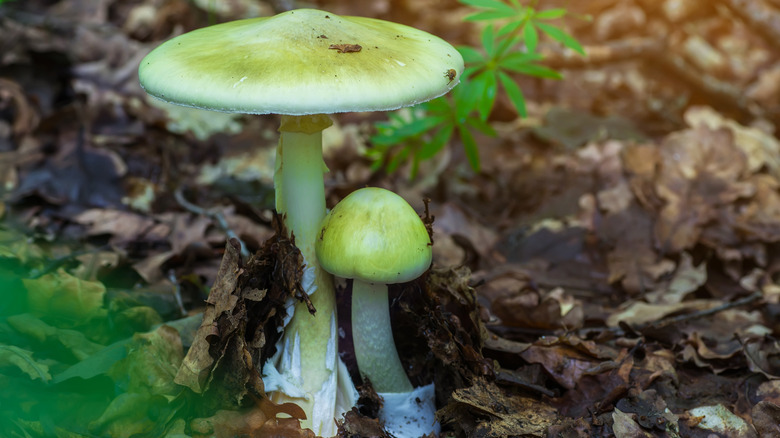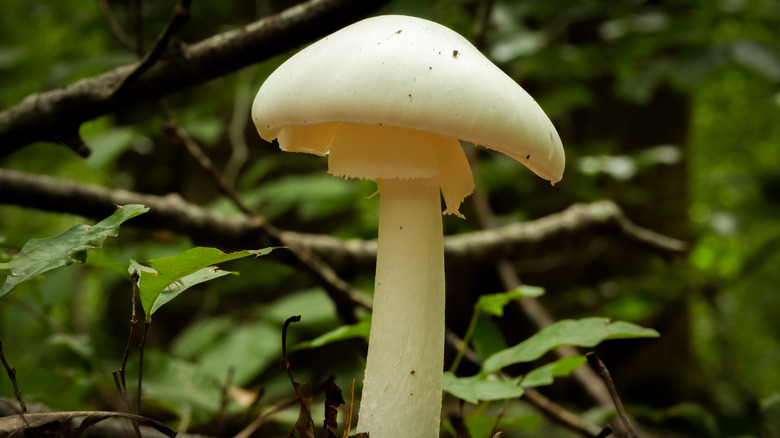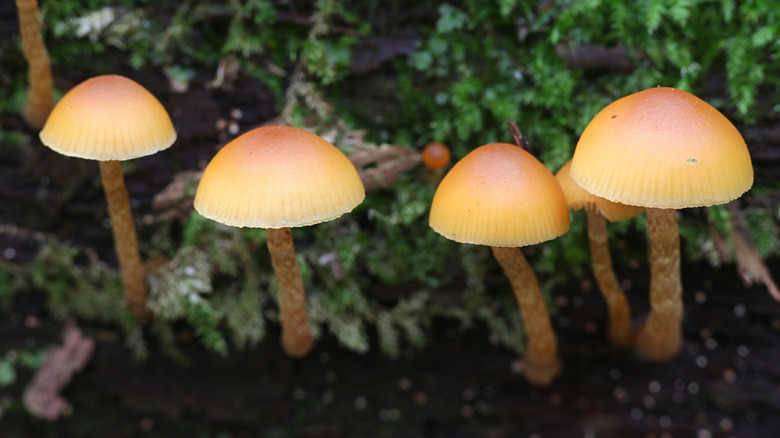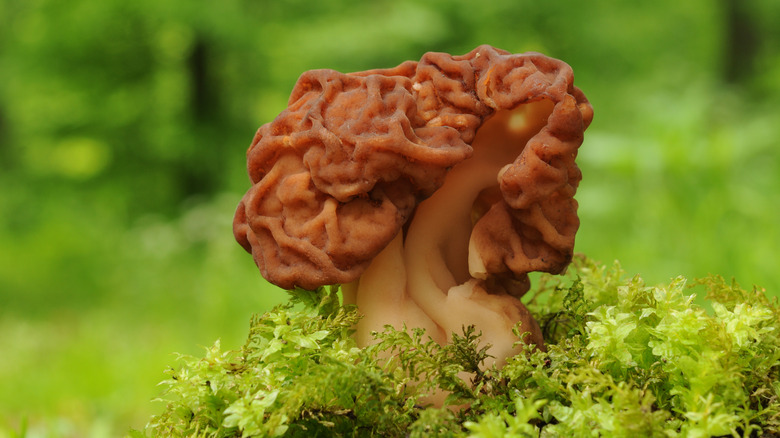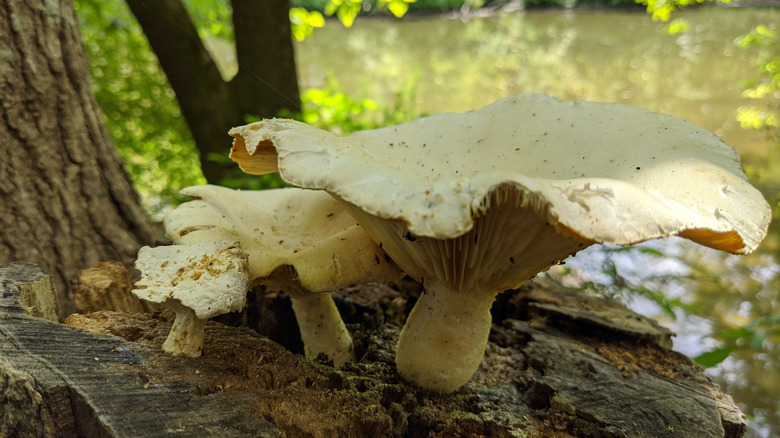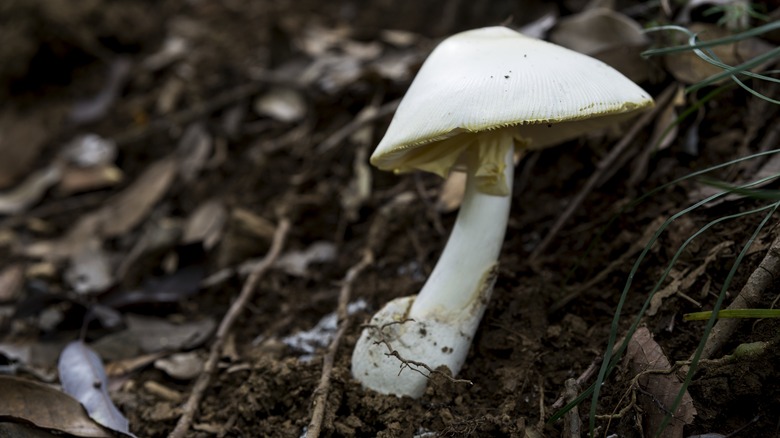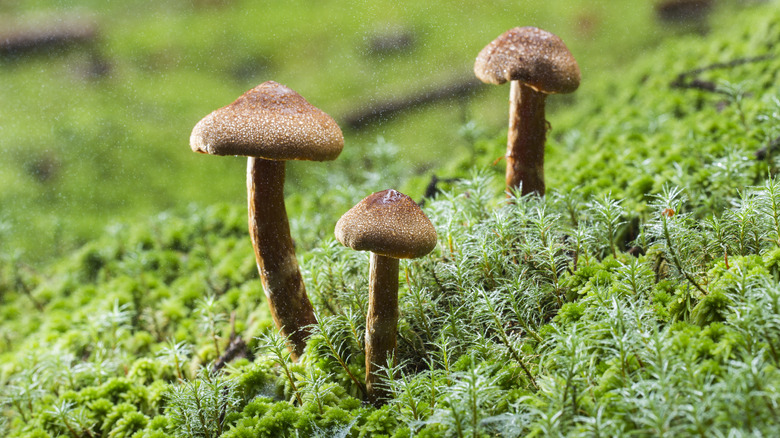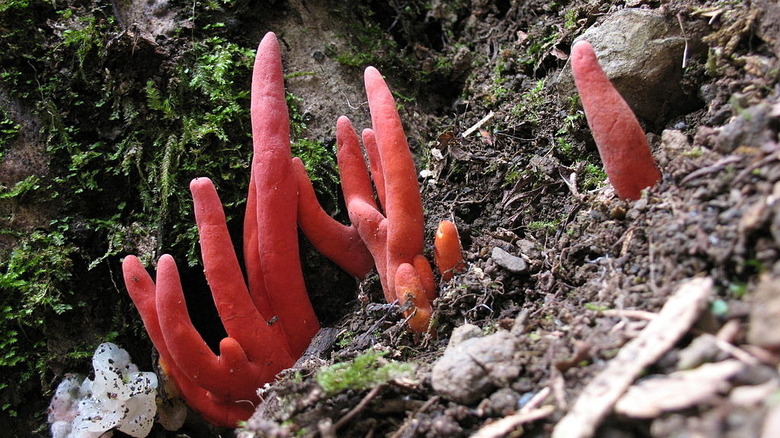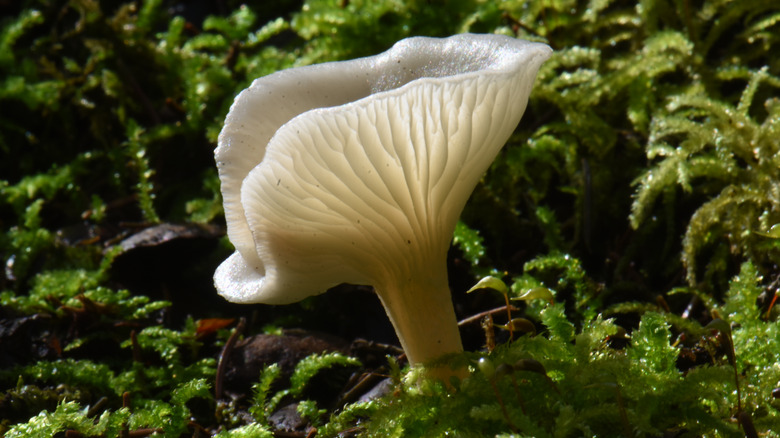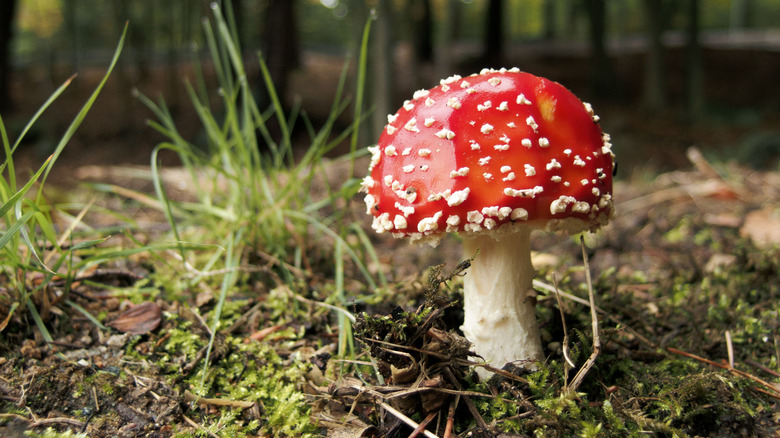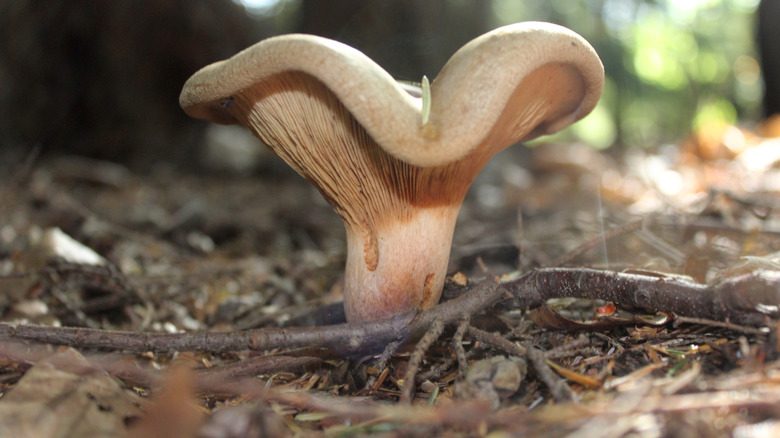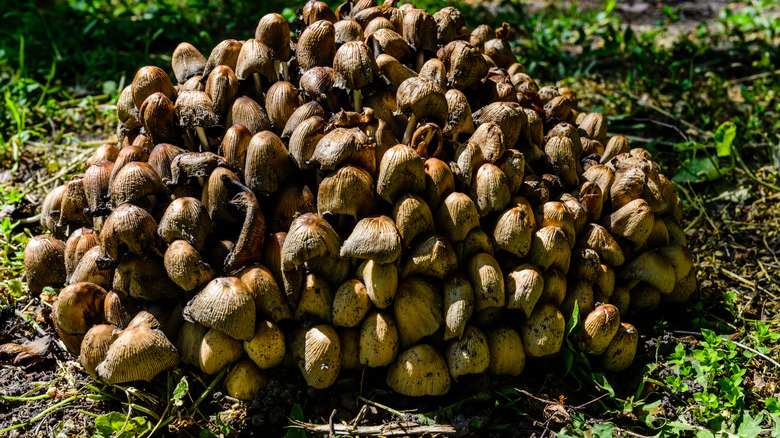Deadliest Mushrooms In The World
Mushrooms are a type of fungus that many chefs and regular people enjoy adding to their favorite dishes. You can sauté them, add them to pasta, stuff them, or put them on pizza. They can be a complete side dish, a soup ingredient, or added to a risotto. You can grill them, put them in gravy, or add them to lasagna. The possibilities are practically endless. Popular edible mushrooms include shiitake, white button, oyster, and portobello.
Most people know that not all mushrooms are made for cooking and consuming. In fact, some are poisonous and can kill you if you eat them, and there's even one type of mushroom that has toxins which can be absorbed through your skin by simply touching it. The good news is that you're pretty safe if you purchase your mushrooms at the grocery store. They've been vetted and are safe to eat. However, if you like to forage and find your own ingredients in nature, then you have to be extremely careful about the specimens you pick.
Unless you know what you're doing, its inadvisable to pick wild mushrooms and eat them. You really have to do your research to make sure the species is edible. If you eat the wrong type of mushroom, you may get sick or, even worse, die. Eating the wrong mushrooms can cause cramps, vomiting, nausea, and other issues, including, shall we say, brain disturbances. Here are the world's deadliest mushrooms, so you know which ones to avoid.
Death cap (Amanita phalloides)
The death cap mushroom, scientifically named Amanita phalloides, is the world's deadliest mushroom. That's because it poisons and kills more people annually than any other type of mushroom on Earth. Symptoms don't appear until six to up to 24 hours after a person ingests it and include stomach cramps, vomiting, and diarrhea, according to Slate. One major problem is that the victim may not correlate the symptoms with the mushroom and instead may blame another illness, such as a stomach flu.
To complicate matters, if the individual is hydrated, the symptoms become less severe, even though the damaging toxins continue to course through their body. Eventually, the liver and kidneys will start to fail, leading to coma and death. The death cap's amatoxins can't be removed by baking, cooking, freezing, or drying them. Even worse, those who've tried them have reported that they're quite tasty.
In the early stages of growth, these mushrooms resemble edible white species, such as Agaricus campestris, also known as the common field mushroom. When fully grown, death caps still look like safe-to-eat mushroom varieties. The good news is that if the individual still has liver and kidney function after eating the death cap and can drink enough fluid to urinate regularly, they should be able to get rid of the amatoxins. The challenge, however, is that mushroom poisonings are rare, and it can be difficult to diagnose the issue in time to help the patient.
Destroying angel (Amanita virosa)
The destroying angel contains amatoxins like the death cap. Within five to 12 hours of consumption, an individual will start having stomach pains, nausea, and gastrointestinal issues such as diarrhea, according to First Nature. These symptoms can then lesson for a few hours or as long as a couple of days, making the person think they're in the clear. Unfortunately, the symptoms come back even worse than before, and by then, there's a good chance that the kidneys and liver have been damaged — not something you want to experience.
If not treated following ingestion, an individual will fall into a coma and die. Those treated further along in the process will require surgery or even a liver transplant. The worst part is that recovery isn't guaranteed, it can take longer than expected to get well again, and the whole process is painful.
The destroying angel is solid white, similar to the button mushrooms you find in the grocery store. It's an attractive fungus and doesn't emit an offensive odor, although older specimens have a slightly unpleasant smell. These deadly mushrooms can be mistaken for the wood mushroom, field mushroom, common puffball, and stump puffball.
Autumn skullcap (Galerina marginata)
Autumn skullcap mushrooms are very cute, but you definitely shouldn't eat them. They've been given many names for a fungus, including the deadly galerina, Rebrasta patuljarica, Galerina marginata, and Galerina autumnalis. Like other poisonous mushrooms, autumn skullcaps contain amatoxins, which are deadly. Individuals who eat this mushroom will have to cope with vomiting, diarrhea, hypothermia, liver damage, and possibly death if they do not receive timely medical intervention, according to Project Noah. It can take up to 24 hours for symptoms to occur, and while they may disappear for a short period of time, they will return with a vengeance, reports Tom Volk's Fungi.
This mushroom grows in Asia, Australia, Europe, and North America and is commonly found on conifer wood that is decaying and falling apart. The caps are brown to yellow and fade as they dry. They're typically 1 or 2 inches wide, and the stipes (stems) are usually around 4 inches in length. These little brown mushrooms resemble many edible varieties, including the honey or velvet stem mushrooms. The difference is that the autumn skullcap features rusty brown spores, while the honey and velvet stems have white spores. Thankfully, since autumn skullcaps are so small, mushroom hunters often pass them over while looking for larger varieties.
False Morel (Gyromitra esculenta, Verpa, Hellvella, and Disciotis)
False morel mushrooms encompass more than one species and even genus. For example, Gyromitra esculenta is commonly called the red mushroom or the beefsteak mushroom. When ingested, symptoms include dizziness, nausea, vomiting, headaches, diarrhea, and possibly death. That's because the fungus contains gyromitrin, which is toxic and potentially carcinogenic, according to The Great Morel. Some people claim boiling small pieces of this mushroom can remove the toxin, yet the species can still cause nasty side effects, so it's not really worth the trouble.
Even preparing a false morel can be tricky because you want to avoid breathing in the fumes it produces. Since there are so many varieties, some are less toxic, but you do you really to take that chance when your life is at stake?
There are several varieties of false morel with different characteristics, but they have some commonalities. The cap or head resembles a brain, and the mushrooms are wrinkled and brittle. These fungi are red or brownish red and turn blackish red when they mature. They can be between 2 and 10 inches in size. Unlike other morels, false morels are not hollow inside.
Ivory funnel (Clitocybe dealbata)
There is some debate as to whether the ivory funnel, also known as Clitocybe dealbata, is the same species as the fool's funnel (Clitocybe rivulosa), according to Wild Food UK. One difference is that C. dealbata grows inland, while C. rivulosa grows towards the shoreline. Either way, the ivory funnel is extremely poisonous, and the muscarine that it contains is deadly. The good news is that those who ingest this mushroom can be treated with atropine. Still, it's not a good idea to mess with ivory funnels.
The cap of the mushroom is convex and can flatten in the middle. It has an edge that rolls inwards. Younger specimens are white, and they turn pale gray and brown as they mature. The ivory funnel has a white stem and no skirt, and it is often found in rings or troops in fields, pastures, lawns, and next to paths and roads. These mushrooms typically grow from summer through autumn in North America and Europe, according to The Mushroom Diary.
Fool's mushroom (Amanita verna)
An individual who eats a fool's mushroom will experience liver failure if he or she is not treated right away, according to Ultimate Mushroom. The mushroom contains the toxin alpha-amanitin, which is poisonous and can be fatal. It takes six to 24 hours for symptoms to occur, and they include cramps and diarrhea. The symptoms eventually fade, and people think they have recovered before everything takes a turn for the worse. Kidney and liver failure occur, requiring a transplant for survival in some cases.
This white mushroom has a silky and shiny-looking cap that turns yellowish as it matures. The stipe is larger at the root and can grow up to 4 inches long. It does not emit a smell until it ages, and the subsequent odor is not very pleasant. You can find this mushroom in European woodlands during spring, and some may mistake it for the edible wood mushroom. However, the gills on the fool's mushroom are white, while the gills on the wood mushroom are pink or brown, depending on its age.
Deadly webcap (Cortinarius rubellus)
The deadly webcap, also known as the Cortinarius rubellus, is rather rare, and as the name implies, it's best to avoid it. It grows in Scandinavia and other areas of northern Europe from summer to winter in coniferous woods, according to First Nature. Some people mistake it for chanterelle mushrooms, which can have deadly results, because chanterelles aren't loaded with a toxin called orellanine. For example, writer Nicholas Evans (author of "The Horse Whisperer," "The Last Song," and many other best-selling novels) and three family members ingested the mushroom thinking it was a chanterelle variety and had to be treated in a hospital in Scotland for kidney damage.
Recovery takes a long time and is painful. Even eating just a tiny amount can cause organ damage or failure. Symptoms of orellanine poisoning don't occur for two to three days, and they include vomiting and headaches. If a patient is not treated in a timely manner, kidney failure and death can occur. The mushroom's cap is tawny brown to orange, and it flattens as fungus ages. The stipe of the deadly webcap is typically bowed and is paler than the cap.
Poison Fire Coral (Podostroma cornu-damae)
The poison fire coral looks like something you'd see deep in the ocean. It is unique (and terrifying) in that it is the only toxic mushroom in which toxins can be absorbed through the skin, according to mycologist Matt Barrett of James Cook University. He told Popular Science in 2019, "If found, the fungus should not be touched, and definitely not eaten." The mushroom contains a variety of trichothecene mycotoxins that, when ingested, can cause a "horrifying array of symptoms," including stomach pains, vomiting, peeling skin, hair loss, and even cognitive impairment related to movement, speech, and perception. That's right: This mushroom can cause brain damage. Specifically, poisoning from it can shrink your cerebellum.
Those who aren't treated can experience organ failure, necrosis, and death. Symptoms occur based on the dosage and can take weeks to appear. And like many of the other mushrooms on this list, it resembles edible varieties during its early development, including Ganoderma lucidum and Cordyceps. Experts initially believed it was endemic to just Korea and Japan; however, it has also been found in Australia, Java, and Papua New Guinea.
Angel wing (Pleurocybella porrigens)
Angel wing mushrooms, also known as Pleurocybella porrigens, feature an unstable amino acid called pleurocybellaziridine. And it's a mushroom you should avoid eating at all costs. In 2004, 59 people got sick in Japan after ingesting the mushroom, and 17 died from acute encephalopathy (in other words, severe brain disease), according to the North American Mycological Association. Most deaths also involved kidney failure.
In Japan that year, these angel wings, or sugihiratake as they are called in the country, grew larger than normal following heavy rains, getting as big as a human hand. Symptoms from the toxins didn't appear until 13 to 18 days after consumption and included sub-acute tremors, extremity weaknesses, fevers, intractable seizures, and consciousness disturbances. Brain images showed lesions in the cerebral cortex. It's unclear exactly why these particular mushrooms were so toxic in 2004. It may have been due to the weather conditions or because people with kidney conditions consumed them in such large quantities, creating a lethal combination.
This white-fleshed fungus resembles a small oyster mushroom. Interestingly, older field guides labeled it safe to eat, according to Learn Your Land. These days, it's considered toxic, poisonous, and deadly.
Fly agaric (Amanita muscaria)
The fly agaric hallucinogenic mushroom isn't quite as deadly as some other mushrooms. It's sometimes called a magic mushroom due to its psychoactive chemical compounds. These compounds are also toxic, though, making it poisonous. Symptoms experienced after ingestion include drowsiness, nausea, sweating, dizziness, distortion in vision and hearing, and euphoria, according to First Nature. The severity of the symptoms is based on the individual who consumes them as well as the amount consumed and the level of toxins in the particular fly agaric ingested.
So, does it actually kill its victims? Evidence is inconclusive, but people using it as a recreational drug may have died after consuming it. Either way, it can cause terrible stomach cramps when eaten raw. It's interesting to note that the fly agaric mushroom appears in Lewis Carrol's "Alice in Wonderland." The titular character takes a small bite of the mushroom, grows shorter, and doesn't feel like herself after consuming it. It makes you wonder if the author had dabbled with some Amanita muscaria.
This mushroom grows in North America, Europe, and Asia and is red and covered in white warts in America. Its name refers to its historical use as an insecticide in Europe. When mixed with milk, it attracts, poisons, and kills houseflies.
Brown roll-rim (Paxillus involutus)
People used to believe that the brown roll-rim was edible as long as it was cooked properly. One of its toxins can be neutralized as long as the mushroom is boiled and the water is repeatedly rinsed away. But it has another toxin that can't be removed and can build up over time, leading to death in some circumstances, according to Wild Food UK.
You should not eat this mushroom if you value your life. Some people in Eastern Europe do so despite its deadly reputation, and as a result, some of them die. In 1944, a German mycologist (fungi researcher) named Julius Schäffer was killed after eating meals made with the brown roll-rim. He is reportedly the only professional mycologist to have died due to fungus poisoning.
This mushroom can be found in North America, Australia, Asia, New Zealand, and Europe, according to First Nature. It is brown and yellow with a rim that rolls under itself. According to the Woodland Trust, this poisonous mushroom's toxins can create an autoimmune reaction. The body attacks its red blood cells, which can be deadly. One problem with the brown roll-rim is that it resembles edible field mushrooms, such as the penny bun.
Deadly fibercap (Inocybe erubescens)
The deadly firecap, aka Inocybe erubescens, is also known as the red staining Inocybe and brick-red tear mushroom. It has a toxin called muscarine in much higher amounts than the fly agaric mushroom (Amanita muscaria), and it can be deadly. One death was recorded in Surrey, England, in 1937, according to Ultimate Mushroom. Many people in Israel mix it up with Tricholoma terreum and Suillus granulatus because they grow in similar areas. This mushroom features a bell-shaped cap that is pale pink with red stains and a reddish-pink stipe and gills.
It emits a strong, pungent odor that has been described as both perfumed and fruity. Those who have tasted them say they are sweet, but they should be avoided due to their toxicity. Deadly firecaps grow in summer through autumn in southern England and southern mainland Europe, according to First Nature. Since many Inocybe species are deadly and challenging to properly identify, experts recommend avoiding them completing when foraging for fungi to consume.
